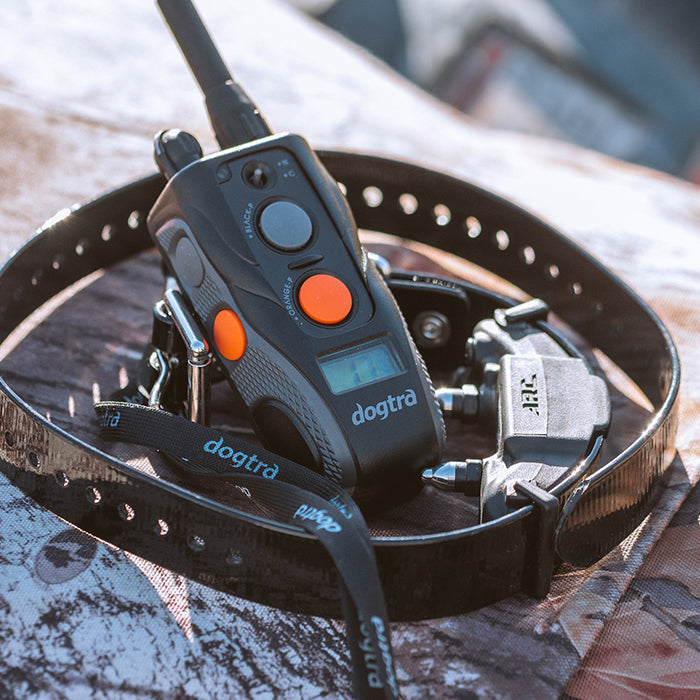WHEN DO I STOP USING MY E-COLLAR?

Would you look at me incredulously if I asked you when it would be ok to stop wearing my seatbelt or stop carrying car insurance? You might tell me it would be fine if I never planned to drive or ride in a car again. But beyond those two extremes, I imagine you would suggest it’s a wise idea to keep the seatbelt and insurance in place just in case they were needed.
I always reference the “just in case” concept when training clients ask me when they will no longer need their e-collars. I recommend that dogs wear their e-collars to clients that plan to take their dog off leash, regardless of how well trained the dog is believed to be. The e-collar might end up being the insurance policy you wish you had available in the event something out of the ordinary happens.
I’d also like to point out that the idea that a dog has been “trained” is a bit of a misnomer. As a general rule, there isn’t a finished or “over and done” point that is reached. If we apply the same thought process to human behavior we can find all sorts of examples where reinforcement should, in theory, no longer be necessary. For example: Once we’ve completed driver’s education and we’ve been trained to follow the rules, we seem to still require some police presence to maintain orderly and polite driving habits.
Using a workforce analogy, it seems once we’ve been trained to do our jobs, we shouldn’t need managers who hold us accountable to ensure we show up on time and stay on task with our duties.
The moral of my analogies is that behavior isn’t permanently altered through training; it requires some level of continued maintenance.
I think the real question about how long do I have to use the e-collar is actually about how we wean back from using it and how do we not create a dependency on it?
Let me share the following recommendations which are based on my training programs. These assume you’re putting in two or three training sessions per day, five or six days out of the week. Beyond the formal training sessions, this approach also assumes you are having the dog wear the e-collar and you’re using it as needed to enforce behaviors throughout the daily routine. If you aren’t able to work with your dog that frequently you will need to adjust the recommendations to fit the amount of actual repetitions you’re getting in and increase the time lines accordingly.
In the first week of collar conditioning, use the e-collar 90% of the time you are training and enforcing commands with your dog. This level of consistency allows your dog ample opportunity to really learn how to respond to and have control over the stimulation. When not using the e-collar to enforce, use a leash, physical modeling, lure/reward techniques or your tool of choice, but DO NOT put yourself in a situation where the dog can fail to respond appropriately.
In the second week, you can begin to give more opportunity for the dog to avoid stimulation by reducing your prompts by another 10-15%. This means by the end of week two you’re still using the e-collar to prompt behavior 75% of the time you give a command. It also assumes you are using the e-collar to immediately enforce any commands that are ignored or missed by the dog due to higher levels of distraction.
By the end of week two, you should be over the hump of your dog experiencing any significant confusion. The dog should be responding quickly and confidently to the commands that you’ve associated with e-collar stim. Now you can begin a 50% reinforcement schedule. This means that 50% of the time you automatically prompt with the e-collar and 50% of the time you give the dog opportunity to avoid stimulation all together…thereby giving them control and creating the belief they can “beat the stim” by responding quickly and correctly.
Stick with the 50/50 ratio for two to three weeks. By the end of this time frame you will be four to six weeks into a new training mindset and new habits are starting to form. You can now play with your reinforcement schedule and give your dog more opportunity to “beat the stim”. Just be careful not to repeat commands without reinforcement thinking that your dog didn’t hear you. Don’t give chances that aren’t earned. The coming months are where having the e-collar on becomes very important to your overall level of consistency.
I caution you from thinking your dog is “trained” and therefore you won’t need the e-collar. I’ve seen too many instances of people weaning off e-collar use too quickly or going without the e-collar on in situations where the dog was almost destined to fail due to higher levels of distraction. The dog became inconsistent in response and sometimes, collar wise, simply because the owner becomes lax in reinforcing commands since the e-collar wasn’t on or the remote wasn’t in hand.
Without some form of reinforcement (this also includes positive reinforcement for a job well done) dogs end up back at square one and need to start the process all over.
When you find yourself out and about with your dog and you seem to never need to push the button, keep the remote in your pocket and pat yourself on the back for a job well done!!
Happy Training,
Robin




